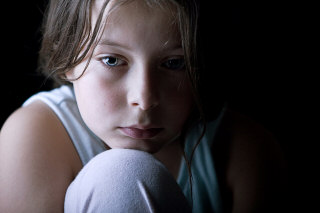Silent Bully: What Every Parent and Child Should Know
 We are all familiar with the term "bully." It is a term used for instances
when someone pushes another around in various ways. For example, a child may
take another child's lunch money or other things by threatening them. Or it
could be someone calling another names and degrading them. Bullying often leads
to fighting. A bully may continue until the victim has had enough and an all out
brawl ensues. We are all familiar with the term "bully." It is a term used for instances
when someone pushes another around in various ways. For example, a child may
take another child's lunch money or other things by threatening them. Or it
could be someone calling another names and degrading them. Bullying often leads
to fighting. A bully may continue until the victim has had enough and an all out
brawl ensues.
Bullying Can Have Serious Effects On a Child
Generally, a person becomes a
bully early on in childhood for various reasons. Possibly they have seen it at
home from a parent or older sibling. Often times a child becomes a bully because
they, themselves, have been victims of name-calling or been made fun of because
of their size or the way they look. A bully tends to choose a victim who may be
quiet and withdrawn because this makes them feel superior in every sense. It
typically makes them feel that by making another feel small and worthless they
are taking away from their own shortcomings that they imagine they have.
Victims of a bully tend to become withdrawn. They feel a sense of
worthlessness. As time progresses, and without intervention, some lose their
social interactions. They may resort to drugs or alcohol to ease the pain. Too
often, if left unnoticed, a victim of a bully may become so withdrawn that they
drastically take their own lives as a means of escape.
We, as humans, tend to take what others say into our thoughts. Over time, if
repeated, we begin to believe that this is the case. This is especially true
with children. They are impressionable, young lives that can either flourish
with their peers or crack under the pressure.
Role Models Are Reaching Out and Making a Difference
Over time, bullying has
become a much noticed factor in society. More emphasis has been put on this
today than in the past. Teachers, parents and other role models have realized
just how drastic a situation this has become, and are stepping up and speaking
more openly with children. Children have begun to speak out. The magnificent
discovery of the internet has given those with a voice a chance to reach the
nation and even the world.
As a result, the number of bullies in schools has decreased. Some children
are not afraid to go to school, as they once were. There has been a decrease in
the number of young suicides, which, until a few years ago, were rapidly on the
rise.
Are We Possibly Missing Something?
 There is one form of
bullying that tends to
be overlooked. Because it does not appear to have the same characteristics as
our definition of a bully, we do not typically consider it but it exists. And
we, as leaders and role models of our youth, need to come to that realization.
It is: silent bullying. There is one form of
bullying that tends to
be overlooked. Because it does not appear to have the same characteristics as
our definition of a bully, we do not typically consider it but it exists. And
we, as leaders and role models of our youth, need to come to that realization.
It is: silent bullying.
All children in the world have differences. Their characteristics and traits
make up who they are. Some children have a disability or a different feature
about them that makes them just a little more unique.
As time has progressed, and we have learned more of these special needs
through education and media, we have begun to see a softer side to our
generation. These children are in public schools, in regular academic classes
and even have sporting activities designed around their needs. This tends to
fair well when those children are younger. Children of that age are typically
taught to share and include everyone. But what happens when those children are
older?
As Children Grow, Their Thoughts and Ideas Change
As they enter into middle
school, things begin to change. They start to notice boys and girls in a
different light. Eventually they exchange phone numbers with friends and begin
to attend birthday parties, slumber parties and even dances. They "hang out" to
talk in the school hallways in between classes. And where are the special needs
children or the children who are slightly different when such time comes?
As the friendships reach a new level, these children are left sitting alone
at the lunch table. If someone is sitting next to them, they are usually
enjoying conversations with those around the child but not with the child. That
child begins to feel unwanted.
In the gymnasium, the older children sit on the upper levels of the
bleachers. Most special needs children cannot, for one reason or another, join
them. This leaves them sitting on the bottom row without their peers.
When the children are home exchanging phone conversations with their friends,
most special needs children are home talking with mom or dad or anyone who will
listen. They generally do not have several friends to call. They do not receive
invitations to parties and sleepovers.
We Simply Do Not Realize
Children today, in no way mean any harm to a child
with special needs. Our youth have been raised by an educated generation, and we
have taught them well. But all of us can and do learn every day. And each of us
miss things along the way.
Possibly we are missing a type of bullying that we had no idea even existed.
It's not intentional, nor do we mean any harm. Yet we leave these children out
because we feel they may get hurt or they cannot keep up. In the end, that is
exactly what's happening. For whatever reason, they are spending time alone
that should be filled with friendships and laughter. We all have a need for
that, don't we? This form of bullying is a systemic form that grows out of the
inherent differences children may have.
Become More Aware of Those Around You
 This not only exists in special needs
children or adults. Silent Bullying exists everyday in every walk of life. Take a look around
when you are at the store, park or work. Notice how many people you see that are
alone. How many people spend their lunch break sitting to themselves? How many
people do you notice sitting alone on the church pew? It may surprise you to
know this number will be more than you think. This form of bullying is a
systemic form that grows out of the inherent differences children may have. This not only exists in special needs
children or adults. Silent Bullying exists everyday in every walk of life. Take a look around
when you are at the store, park or work. Notice how many people you see that are
alone. How many people spend their lunch break sitting to themselves? How many
people do you notice sitting alone on the church pew? It may surprise you to
know this number will be more than you think. This form of bullying is a
systemic form that grows out of the inherent differences children may have.
If you have children, ask them to do the same the next time they are at
school or the park. Ask them to look around and take notice of a child who may
be alone at the lunch table or alone in the gym. Possibly they are sitting alone
in a corner of the playground while the other children laugh and play and never
even notice. Remind them that we are all people and we all have differences.
That is what makes each and every one of us unique.
How Would You Feel If It Were You?
Silent bullying is not considered in our
world because it is not typical of a bully. We feel that we are not harming
them. But in the end, the results are the same. If a child or adult feels alone,
unwanted or unloved long enough, the end result may be drastic.
If we can open our eyes to the silence we avoid every single day, we can put
an end to silent bullying. The feelings of self worth will improve. And our
world will be a much better place for it.
Parenting
Silent Bully: What Every Parent and Child Should Know
How to Protect Your Children Against Online Dangers
The Most Common Problems Teenagers Face Today
Tips on How to Manage Your Hyperactive Child
How to Make Your Child Into a Leader
Parenting Children with Learning Disabilities
10 Tips to Communicate Better with Your Child
How to Encourage Confidence in Your Child |